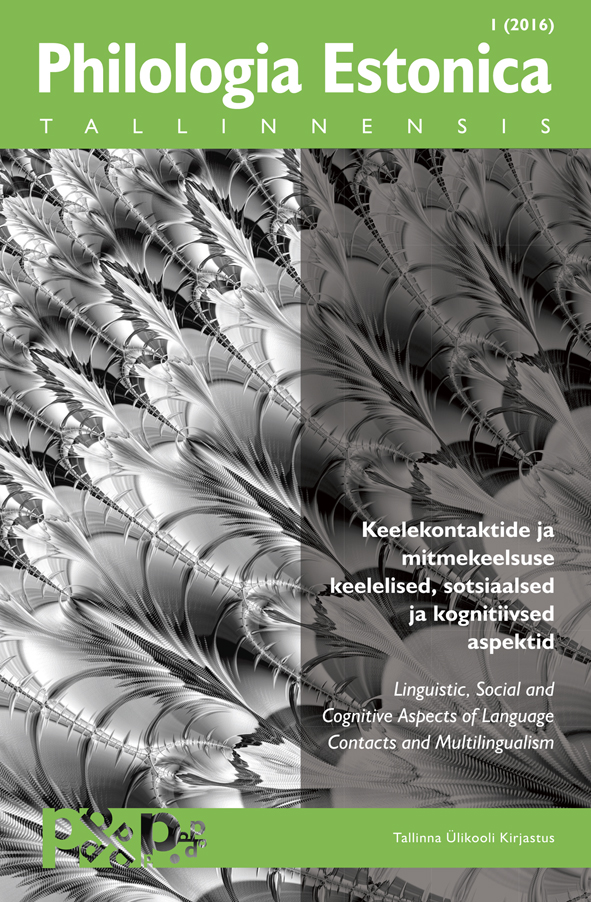
We kindly inform you that, as long as the subject affiliation of our 300.000+ articles is in progress, you might get unsufficient or no results on your third level or second level search. In this case, please broaden your search criteria.

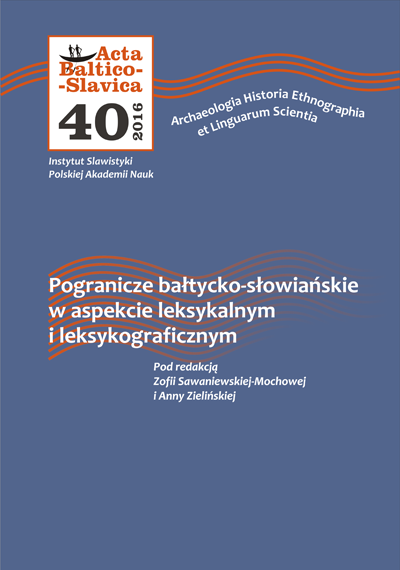
Food is an essential part of the material culture of every nation. It frequently preserves national traditions and old names longer than other spheres do, additionally, it lets observe the influence of other cultures. According to dictionary data, dumplings were known in Latvia already in the 18th century. Many names for them have been attested in regional subdialects of Latvian; borrowings usually cover wide areas. In this article, basing on ethnographic and linguistic material notations of different antiquity thus tracing the use of names for dumplings almost a century long and referring to dictionary data from 18th–19th century, the author tried to reveal the use and distribution of names for dumplings of Slavic origin in subdialects of Latvian, as well as to offer fragmentary data on the use of particular Slavic borrowings in neighboring languages. The Slavic borrowings kļocka, zacirka alongside variant names are widespread in Eastern Latvia, i.e. in a rather narrow or wide area of the High Latvian dialect. In Eastern Latvia, the names klučki, klučkas derived from the Germanic borrowing kluči, with insertion of the consonant k under influence of Russian, have also been registered. From the semantic angle, the borrowings kļockas, klučkas and their variants are denoting dumplings made of various raw materials (e.g., different kinds of flour, also pea-flour, potatoes). Further references to ingredients of this food and its preparation are included in the explanation of the Slavic borrowing zacirka and its variants most typical for the peasants vocabulary in Latgale.
More...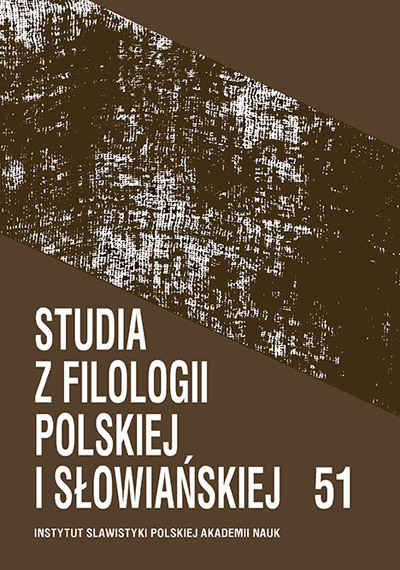
The Clarin Eric and Clarin-PL strategic scientific purpose is to support humanistic research in a multicultural and multilingual Europe. Polish researchers put the emphasis on building a bridge between the Polish language and Polish linguistic technologies and other European languages and their linguistic technologies. So far, the Polish scientific community has mainly focused on Polish-English connections. Clarin-PL has been developing the first and only multilingual corpora of the Polish language in conjunction with other Slavic languages and the Lithuanian language: the Polish-Bulgarian-Russian Parallel Corpus and the Polish- Lithuanian Parallel Corpus. The parallel corpora created by the ISS PAS Corpus Linguistics and Semantics Team break through the existing “canons” and allow scientists access to interlinked multilingual language resources – in the first phase limited to the languages of the three Slavic groups and the Lithuanian language. In the article, the authors present very detailed information on their original system of the semantic annotation of scope quantification in multilingual parallel corpora, hitherto unused in the subject literature. Due to the system’s originality, the semantic annotation is carried out manually. Identification of particular values of scope quantification in a sentence and the hereby presented attempts of its recording are supported by long-term research conducted by an international team of linguists and computer scientists / mathematicians developing the issue of quantification of names, time and aspect in natural languages.
More...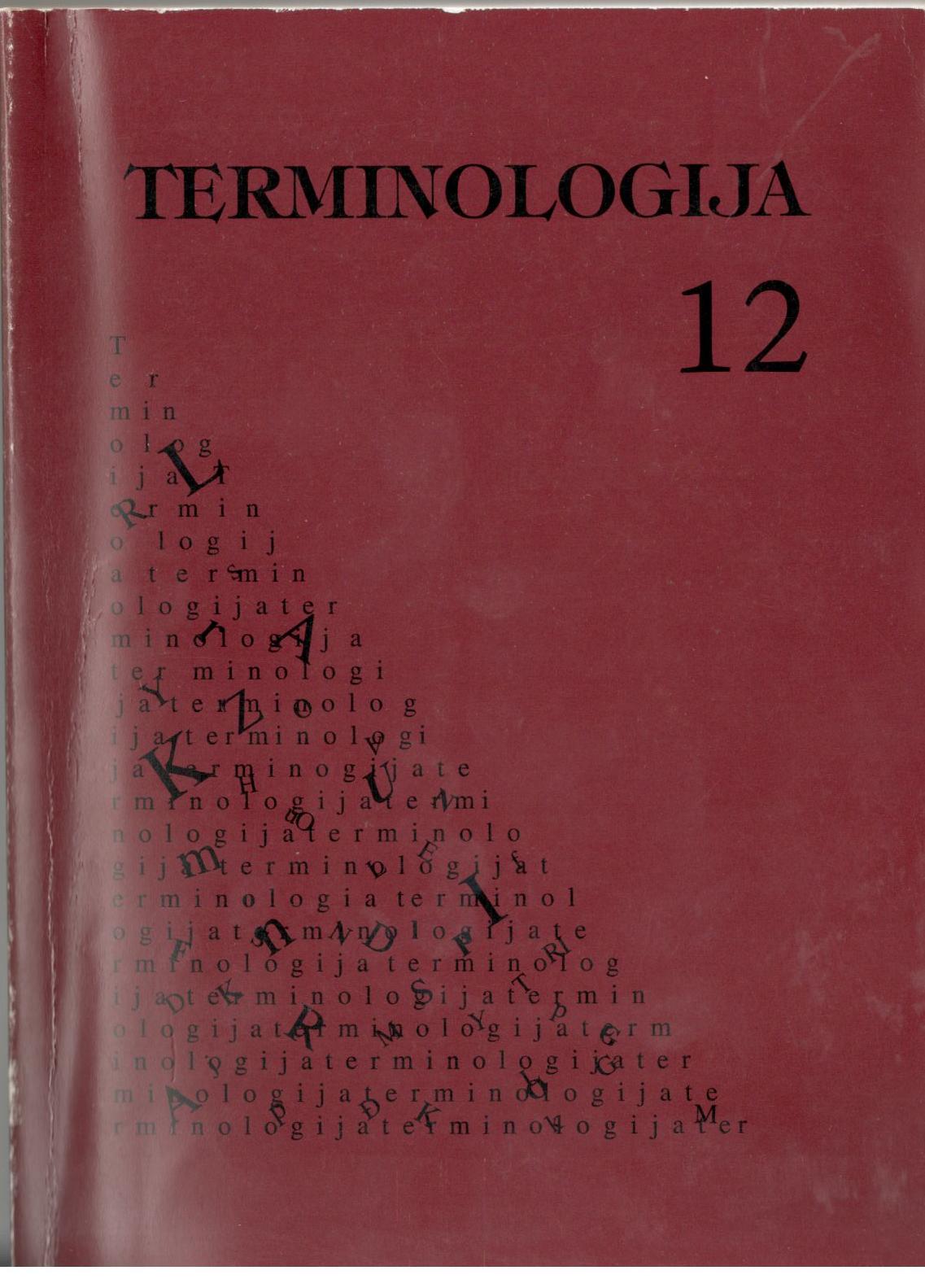
Lithuanian Christian terminology is one of the oldest fields of terminology – the old borrowings (for instance, bažnyčia (church), gavėnia (Lent), krikštas (baptism), kūčios (Christmas Eve), Kalėdos (Christmas), Velykos (Easter)) came into Lithuanian before the official conversion of Lithuania to Christianity – in 10th-12th centuries. The beginnings of Lithuanian terminology are found in extant manuscripts of prayers (Viešpaties malda (The Lord’s prayer), Angelo pasveikinimas (Hail Mary), Tikėjimo išpažinimas (The Nicean Creed) written down in Vilnius diocese in the 16th century, which are the oldest of all presently known texts and the first printed Lithuanian book – an evangelical Lutheran catechism Catechismvsa prasty Szadei written by Martynas Mažvydas in 1547. This article analyses one-word non-Lithuanian origin terms of religion used in Catholic catechisms from the end of the 19th and the beginning of the 20th centuries. This period is not a random choice, because the literature of the Church and its language at that time were corrupt with barbarisms.From four Catholic catechisms published at that period – Mokslas Rimo Kataliku (Teaching of Roman Catholics) (1879), Trumpasis Кип. Filochowskio katekizmas. Vaiszganto verstas (Short Catechism by Priest Filochowski. Translated by Vaiszgantas) (1901), Katakizmai katalikiszki (Catholic Catechisms) (1903) and Tikybos mokslas (Šv. Istorijos ir Katekizmo) (Teaching of Religion (Holy History and Catechism)) (1916) by the priest Kazimieras Paltarokas – 1158 one-word terms of religion and their variants, were picked up. Some terms were the same, so it made 613 different terms and 125 their variants. The majority of one-word terms – 439 terms – were of the native origin. This article investigates 141 different terms of non-Lithuanian origin and 33 hybrid terms of foreign origin.Non-Lithuanian, i.e. terms of religion of the foreign origin are so called international words (34 terms), barbarisms (71 term) and old borrowings (36 terms). The absolute majority of international terms (33 terms) are derived from classical languages – Latin (aktas (act, note) TFK 43, ostija (host) KK 30, MRK 322, TM 123, sakramentas (sacrament) MRK 16, 79, 138, TFK 9, KK 22, TM 72, 85) and Greek (antifona (versicle) TM 11, balzamas (balsam) MRK 315). Some international terms came through Slavonic (Belorussian, Polish) languages, for instance, altorius (altar) MRK 176, TM 110, adventas (advent) MRK 79, 333, TM 109, angelas (angel) TM 12, 76 and other.The origin of old borrowings varies. These catechisms have majorily old borrowings from Slavonic languages, for example, bažnyčia (church) MRK 25, TFK 20, 25, KK 19, TM 7, 88, grabas (coffin) MRK 75, KK 15 and other. This is the oldest layer of Lithuanian terms of religion.There are many barbarisms in earlier mentioned catechisms (71 term): Polonisms (abrozas (picture) MRK 79, dūšia (spirit) MRK 29, TFK 8, KK 11, tajemnyčia (mystery of rosary) MRK 50), Slavonicisms (apieka (care) KK 10), Belorussianisms (тūkа (suffering) MRK 57, TFK 11, 25, KK 46) and germanisms (podžiai (godparents) TM 120).The end of the 19th and the beginning of the 20th centuries is the period of the fast creation of common language. At that time terms of religion were already established, but the language was corrupted with barbarisms and was not pure. In the beginning of the 20th century there were attempts to normalize terms of religion – barbarisms were changed, international terms and old borrowings were left. In the work of the priest K. Paltarokas Tikybos mokslas (The Teaching of Religion) even 82% of terms are purely Lithuanian. In this catechism there is only one barbarism from German language – podžiai (godparents) TM 120. Furthermore, barbarisms, used in catechisms published in 1879-1903, were changed, for instance, dirmavonė MRK 108, TFK 9, KK 27 – sutvirtinimo sakramentas TM 120 (confirmation), čysčius MRK 63, TFK 17, KK 16, 37 – skaistykla TM 89 (purgatory) and others. After the bishop Paltarokas the terminology of Lithuanian catholic catechisms hardly changed.
More...
This article analyses the names of treatment means (over 400) collected from sixteen books of popular medicine by doctor Antanas Vileišis (1856–1919) according to their meaning, expression and origin.In respect of meaning these names differ. Six notional groups were identified – names of medications for internal and external use, bandaging means and medical dressings, first aid means, disinfecting or anti-bacterial means, medical implements and manipulation treatment.In respect of expression the majority of names of treatment means are complex terms, mainly two-word terms (200), also there are quite few three-word terms (nearly 80). A variety of means of expression is characteristic to specific elements of those terms.In respect of origin Lithuanian words prevail, though there are quite a lot of words of foreign origin – international words and barbarisms. In some cases barbarisms were substituted with Lithuanian equivalents, though sometimes the author gives a barbarism next to Lithuanian word – presumably trying to adjust his language to the lexicon used by target readers. The abundance of borrowed words possibly has been influenced by the language, style and terminology of foreign authors, because most of doctor Vileišis books were translations of works of Russian, Polish or German authors or were prepared using such works.The names of treatment means have synonyms and variants. Most frequently two Lithuanian words or a Lithuanian word and non-Lithuanian word are used synonymously.Popular medical books by doctor Antanas Vileišis are the important source for the history of Lithuanian medical terminology.
More...
Sources for the research in this article are unofficial translations of Russian legal codes, which were valid in Lithuania between 1918 and 1940, into Lithuanian. The article analyses terms of law for naming persons. Part of these terms could be attributed to the jurisprudence, other part – to the legal practice. They are names of persons connected by the legal relations and persons performing legal functions. There were about 800 such terms found in the earlier mentioned codes. About half of them are one-word terms, a half of them – complex terms (mainly two-word terms). Terms are discussed according to their origin and word-formation.A characteristic feature of law terms of that period naming persons is their Lithuanian origin. Names of persons, which are separable in respect of word-formation, are rare in those codes, most of them are derivatives. Some of them are coined specially for the needs of law terminology, most of them are terminologized. It is quite difficult to mark strictly terminologized formations from new formations. If a derivative, which is systematically possible, did not get into the earlier lexicography, it is not possible to conclude that such word did not exist. Most of law terms naming persons are derivatives with suffixes -to-jas, -a and -ėjas, -a, which on the whole are very common and productive. It is possible that exactly because of the commonness some terms made with the suffix -tojas, -a were replaced with derivatives with the suffix -ovas, -ė. More clearly new words were made with the suffix -ininkas, -ė.The article singles out a distinctive type of law terms naming persons – substantivized participles, mostly of the passive voice of the present tense. This is quite convenient way of a short expression. Some of the terms of this type are usual until nowadays.Borrowings make quite a small part of law terms naming persons in these codes. Almost all borrowings are international words. An absolute majority of them are of the Latin origin. The Lithuanization of a very few international words differs from the present one, variations are rare. Hybrid terms are close to borrowings, though such way of naming persons in these code was not popular at all.
More...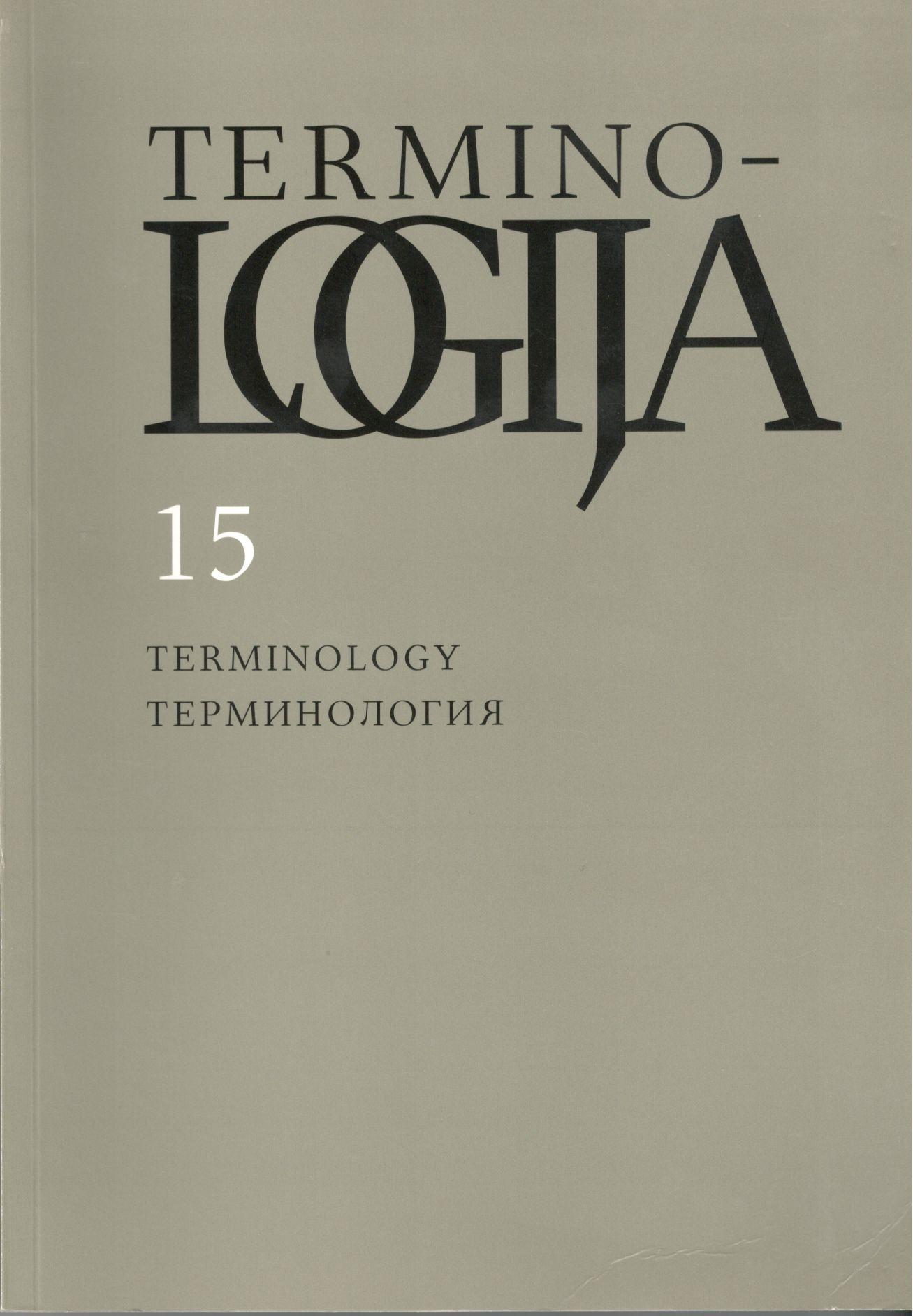
Per beveik penkis šimtmečius latvių, kaip ir lietuvių, kalba pasiekė tokį lygį, kad dvidešimtojo amžiaus pabaigoje mūsų kalbos buvo visiškai pasirengusios atlikti visas aktualias valstybinės kalbos funkcijas savo šalyse. Reguliarūs latvių ir lietuvių kalbininkų kontaktai prasidėjo nuo dvidešimto amžiaus septintojo dešimtmečio, kai buvo pradėtos rengti terminologijos ir kalbos kultūros konferencijos. Septintasis dešimtmetis – tai laikas, kai terminologija, iki tol laikyta leksikologijos šaka, dėl gausių teorinių tyrinėjimų tapo savarankiška tarpdalykine mokslo sritimi, besiplėtojančia lingvistikos ir keleto gretutinių sričių – logikos, filosofijos, kognityvistikos, ontologijos, komunikacijos mokslų – sandūroje. Leksiniu atžvilgiu terminologija laikoma specifiniu kalbos leksinės sudėties sluoksniu, kreipiant dėmesį į terminų ir ne terminų santykį, terminų ir profesinių, socialinių, teritorinių, istorinių, stilistinių ir kitų leksikos sluoksnių sąsajas. Leksinę kalbos sandarą atskleidžia žodynai. Teoriniai ir praktiniai žodynų sudarymo aspektai – leksikografijos, kaip kalbotyros šakos, tyrimų objektas. Viena iš žodynų rū- šių – terminų žodynai. Bendrinės kalbos ir terminų žodynų lyginimas leidžia apibūdinti terminografiją kaip gretutinę discipliną, esančią leksikologijos, leksikografijos ir termi- nologijos sandūroje. Terminų žodynų specifika atsiskleidžia atrenkant žodynų straipsnių antraštes ir leksiškai bei gramatiškai aprašant. Terminų žodynuose vyrauja daiktavardžiai, kadangi jie pavadina pačias įvairiausias realijas – daiktus (objektus), procesus, savybes, kiekius, aplinkybes ir kt. Daiktavardžiai geriausiai įvardija sąvokas. Kitos kalbos dalys, pavyzdžiui, būdvardžiai, dalyviai (t. y. veiksmažodinės formos) paprastai atlieka termino apibūdinančio dėmens funkciją. Kartais, pavyzdžiui, kai kuriuose ISO standartuose, pasitaiko antraščių ir su daiktavardžiais, ir su veiksmažodžiais: display – „vizualinis pateikimas“ ir to display – „pateikti vizualiai“ (apibrėžčių vertimas pateiktas straipsnio autorės). Kaip matyti iš apibrėžčių, abiem atvejais kalbama apie tą pačią sąvoką, skiriasi tik žodžio gramatinės formos pasirinkimas. Toks dubliavimas yra netikslingas. Pakaktų išreikšti sąvoką daiktavardžiu, o veiksmažodis, reikalui esant, gali būti vartojamas tekste. Skirtingų kalbos dalių vietą ir vaidmenį terminologijoje padeda nustatyti terminema, kurios pagrindinis dėmuo yra daiktavardis, o kitos kalbos dalys (susijusios su ta pačia są- voka) – antraeiliai dėmenys (plg. перевод – переводить, переведен, переведенный ir pan.). Pastaruoju metu terminologijoje ieškoma naujo požiūrio, pabrėžiant kompleksinį terminologinių vienetų pobūdį, tačiau tai nereiškia, kad atsisakoma tradicinio požiūrio. Dėmesys turi būti skiriamas ir reprezentacinei, ir komunikacinei termino funkcijai, t. y. termino sistemiškumui terminų sistemoje ir vartosenos įvairovei, atsižvelgiant į kontekstą.
More...
The article considers the results of the comparative research of the Belarusian and Lithuanian terminographies according to a number of criteria. The advantages and drawbacks of each of the mentioned terminographies are analyzed. The necessity to introduce the amendments into modern Belarusian terminographic practice has been substantiated.
More...
The article examines the South Estonian place name cluster Udsali ~ Utsali. This name was used as a peasant surname in the 16th-17th centuries more extensively than in modern-day place names. Attention is also drawn to some mentions from the 16th century which contain the ethnonym-like surname *Udsalane. While in Eesti kohanimeraamat (2016) I conjectured that Udsali is a High German or Jewish loan name, I now believe that the name either comes directly from South Estonian or is a borrowing of nearby southern origin. This surname came into use in the 16th-17th centuries independently in five places near Estonia’s southern border. The old surname Udsali has been compared to the word udsu ‘fog, fluff, plumule’ and the verb udsalõma ‘to hover like fog or dust’. The comparable South Estonian place names Udsu ~ Utsu, which also appear as family names and have previously been used as peasant surnames, are also indigenous. The oldest written mention of Udsu dates back to the 15th century. The meaning ‘fog, fluff, plumule’ could be the basis for the peasant surname, but this is not very likely. Another potential source of the name is the Finnic-Mordvin word for ‘bear’, the Uralic reconstruction of which is *okti. The regular South Estonian equivalent *otś and the genitive form *ote(n) are represented in the word ott, denoting a bear, and the place name Otepää. The place names Otśu, Utso and Udsu could be regarded as having originated from this word. Thus the ethnonym-like surname *udsalane could actually be *utslane ‘bear man’? Another possible explanation for the Udsali name cluster is the connection between the peasant surname and the Belorussian place name Udziela. Presuming that the basis for the surname Udsali ~ Udsalane is an ethnonym no longer in use, one candidate is the, the ancient county Agzele ~ Adsele on the territory of modern-day Latvia, to the south of Southeastern Estonia. The presumed earliest mention of this county comes from the Pskov chronicle from the year 1111: на Очелу (< Очела). In 12th-century Russian chronicles, the inhabitants of Očela are given as Chudes (i.e. Finns). In Old Russian orthography, the short Finnic a was always rendered as o. However, there is no adequate explanation for the change that actually took place in the initial vowel of the name (a > u or a > o > u). The labialization, i.e. change too, of stressed a appears quite often in the local Latvian Malēnieši dialect (as well as in Latgalian). Thus it is plausible that the county name *Odzala and the ethnonym *odzaļi first developed as such in the Latvian-language environment. Borrowed into South Estonian, the initial *ods was adapted to uds. Another possible derivation path is via expressive variation of the ethnonym denoting the neighboring people, wherein the emergence of u could have been supported by the similar-sounding ethnonym ugalane, well known in South Estonia. However, as both of these explanations are somewhat artificial, Udsali and Adsele should be regarded as names that cannot be linked to one another, at least not on the basis of currently existing knowledge. The article presents an improved etymology for the historical place name Adsele (*Adsela) – the name includes the Finnic word *akja ‘edge, brink, border’ an old borrowing from Germanic *agjā. This explanation was first given by Krišjān Ancītis and Aleksandr Jansons in 1967, but their article has remained relatively unknown. It is important to note that this name was initially used for quite a large area, the most important center of which in the 12th century was Alūksne. The original name for the region was later given to the castle built along the Gauja River, called Adsele in German (Latvian Gaujiena, South Estonian Koivaliin). The analysis of the oldest name forms Очела, Agzele and Adsele concludes that the border of the name element goes between Ag+zele, Ad+sele. Thus this name belongs in the same group with a number of other 13th-century Livonian place names ending in -sele: Sattesele, Cubbesele, Vitisele etc. The article does not take a stance on whether the ending -sele (*-sela) contains the weak grade genitive form *-sälä of the Finnic word *selkä ~ sälkä ‘back’ or whether it is a combination of two suffixes (as Paul Alvre has suggested). Therefore, the structures *ad´+sälä and *ad´+se+la are both considered possible.
More...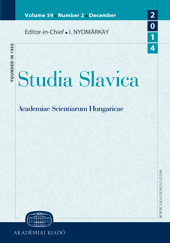
The purpose of this analysis is to present the manner of translating the titles of holy books from Hebrew, Greek, and Arabic by Polish and Lithuanian Tartars and by Polish translators of the Bible and the Quran. It also attempts to define the scope and the nature of relations between the translations of the Bible and the Quran and to present the picture of the books in question on the basis of selected source texts. The source texts vary in terms of form and origin and the vocabulary was excerpted from such materials as historical writings of the Polish and Lithuanian Tartars (the texts were written in Arabic and required transcription and transliteration) as well as translations of the Quran into Polish. The words were also selected from the translations of the Bible (16th-century, 17th-century, and contemporary versions).
More...
The “próstaja mova” is one of the written languages used by both Ukrainians and Belorussians during the 16th and 17th centuries. In this article it is argued that its name is based on a calque of German Gemeinsprache, die gemeine Sprache, a term from the Reformation age. The „prostaja mova” was based on the Ruthenian (Ukrainian and Belorussian) chancery language and developed into a literary language because of its growing polyfunctionality, its increasingly superregional character, and its stylistic variability. The norms of the “prostaja mova” were based on its common usage, not on codification. We discuss the role of Church Slavonic and Polish elements on the different levels of this language and try to show that a “prototypical” text written in the “prostaja mova” was a translation from a real or only virtual Polish text, consisting in the “Ruthenization” of its phonology and morphology and, if it was a written text, in a change of the alphabets - the lexicon and the syntax, instead, remained mainly on a Polish basis. Until the 18th century the Polish language itself had gained so much importance among the Ruthenian gentry that the “prostaja mova” had lost its main addressee and was restricted only to some homiletic and cathechetic works for the common people of the Greek-Catholic Church.
More...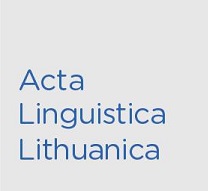
Antoine Meillet was as serious an Indo-Europeanist as there ever was, and yet not everything he wrote is uncontroversial. His take on Balto-Slavic, from Les dialectes indo-européens (1908, 2nd edn. 1922), is one such case – see Szemerényi 1957 – and specifically Meillet’s claim that there is no compelling evidence for a Balto-Slavic subgroup within Indo-European. I explore here just what Meillet meant by “‘dialect’ of Indo-European” in relation to Balto-Slavic, e.g. what gave rise to the 10 (or so) branches (branches as “dialects”) within the Indo-European family, or dialect variation within Proto-Indo-European itself. Further, in the 1922 “avant-prôpos”, Meillet refers to the Indo-European unity as “national” in nature, raising the question of the relevance of Meillet’s sense of the relationship between language and nation (Moret 2013) to the issue of a possible Balto-Slavic unity.
More...
Ewangelie Polskie y Litewskie (hereinafter referred to as JE) by Jonas Jaknavičius was released numerous times since 1647. First JE edition, as mentioned, is dated 1647 (JEI), the second 1674 (JEII), the third 1679 (JEIII), the fourth 1690 (JEIV) and the fifth 1705 (JEV). This is very helpful, because same text, released in several decades, may reflect some changes in a language. The object of the article is Slavic-root words in the first five editions of Ewangelie Polskie y Litewskie. The aim of the article is to determine how usage of loanwords and hybrids was changing in JE during decades: which loanwords or hybrids in same position were changed to other loanwords and hybrids or indigenous Lithuanian words, and vice versa – what indigenous Lithuanian words were replaced with loanwords and hybrids, and determine is there a connection between origin of loanwords and changes in original Polish texts and the alternation of loanwords and hybrids in first five editions of Ewangelie Polskie y Litewskie. To achieve the aim the texts in Lithuanian language in mentioned editions of Ewangelie Polskie y Litewskie were compared with Polish original texts. Although number of words of foreign origin as units in all JE editions is almost the same, there are differences in usage frequencies. Furthermore, in some cases the indigenous word in later editions is replaced by loanword, sometimes on the contrary a single loanword is replaced by indigenous word or even by another loanword. All cases of alternation of words in JE can be classified: 1. Word of foreign origin in later editions of JE is replaced by indigenous word; 2. Indigenous word in later editions is replaced by word of foreign origin; 3. Loanword is replaced by other loanword. The analysis of records in JE leads to the conclusion that there is no connection between origin of loanword and its usage in later (1674, 1679, 1690, 1705) editions of JE. Furthermore, alternation of some words in first five editions of JE wasn’t determined by changes in original Polish texts.
More...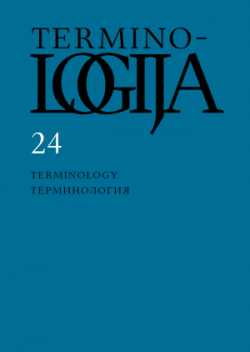
The paper deals with the usage of the fundamental term of terminology sąvoka‘concept’ in academic Lithuanian. The research is aimed at establishing the semantic(contextual) partners of this term and its thematic field and to provide an outline of the concept ‘concept’ according to the usage of the term designating it. This is a corpus-based research, the source of which is Lietuvių mokslo kalbos tekstynas CorALit(Corpus of Academic Lithuanian CorALit) (publicly available at http://coralit.lt). Themain methodology of research is semantic analysis of phrases with sąvoka. Conjunctive usage and contextual synonymy of the term sąvoka which reflect paradigmatic relations of this term were also analysed.The lemma sąvoka was found in the corpus of academic Lithuanian CorALit 779times. It is present in texts from all five fields – the humanities, social sciences, natural sciences, biomedical sciences and technological sciences. In this corpus the term sąvokais one and a half times more frequent than the terminology term termin as ‘term’.In academic Lithuanian the term sąvoka has attributes and is an attribute itself, it is also used as an object or subject and only sometimes as a predicative or adverbial modifier.Attributes describe term sąvoka according to name, space, action, content feature,other evaluating feature, time, place, author, language, object, etc. As an attribute term sąvoka is a secondary name, also a possessor or constituent and more deeply –object or subject of an action or a state, etc.As can be judged from objective phrases a concept is an object of usage, thinking,cognition and perception as well as research, linguistic activities and expression. It is being looked for, found, obtained, given, introduced or eliminated, legitimatized,changed or some other actions are performed in its respect. Besides that, a concept is a result as well as an instrument – not only of an intellectual activity, but also, according to the data of the corpus researched, an instrument of expression. Thus, the features of a term are ascribed to a concept.A concept as a subject includes, has or receives something, it changes something or experiences a change, takes place in space, performs a function or random actions, is in various states, is of some quality or is something, and rarely – simply exists.It can be observed from the conjunctive usage of sąvoka that its correlates are units of expression (including the term terminas), general terms of science and other abstract nouns, names of mental formations and parts or aspects of a concept.The terms sąvoka and terminas are used in academic Lithuanian not only in conjunction,but also as contextual synonyms. The usage of terminas instead of sąvokacould be seen as metonymy. Contextual synonymy of terms can be justified only if it doesn’t affect precision and clarity.Inaccurate usage of terms in texts distorts the results of research; therefore conclusions about the true meanings of terms and concepts named using these terms cannot be drawn solely on the basis of term usage in texts.
More...
Lithuanian terminology research into eponymous terms of various fields (anatomy,architecture, botany, etc.) began in the 21st century. However, a more systematic view that includes the general aspects of the appellativation of terms is still eligible, especially in order to introduce them to the future translators of the subject language, the editors, and other target groups that are interested in the applied and theoretical aspects of the scientific concepts. Although appellativation complements the terminology most often with the borrowed terms, and most eponymous terms were created back in the nineteenth century, it is an active and relevant way of creating new term names. For example, in January 2016 the discovery of four new chemical elements was announced, which, in line with the IUPAC recommendation to give chemical elements the names of mythological figures, minerals, locations, countries or scientists,in June 2016 were proposed to be named as nihon, moskov, tenesin and oganeson. The given terms were legalized on 28th November 2016.An onym loses its individuality in the process of turning into the appellative term,but acquires new features, and and the new words of various structures enter the language system. The article gives a brief overview of the 816 eponymic words from various fields created on the basis of a proper names selected from the Tarptautinių žodžiųžodynas (Dictionary of International Words) (2013), the structural and semantic varieties of the fully appellative terms, by combining linguistic and extralinguistic aspects related to the encyclopedic and scientific knowledge of various fields. According to the field,all the terms are divided into 15 groups (for example, chemistry, physics, mathematics and astronomy, botany, technical, clothing, sports, choreography, etc.). The main method of appellativation is metonymization when there is a strong logical connection between the proper name of a person or an area and a particular object or phenomenon.The oikonyms have become the background for more than 60 percent of the concepts researched, most of which have developed due to egocentric motives. Not only does the appellative onym acquire new semantic components, but it is often derivativelytransformed: among the deonymized terms there are not only grammatically adapted terms (fermis, klarkas), but also there is an abundance of suffixal derivatives(hesianas, mahometonybė, rusoizmas), compounds and blends (atlantozauras, orimulsija).
More...
The rapid development and globalization of science as well as formation of language varieties related to professional activities, the main layer of which is terminology,makes research into terminology very important. There is a noticeable tendency in recent years to create compounds which adhere to the principles of language economy,precision of naming, monosemy and logicality perfectly well. Compounds are researched in various aspects including semantics, word-formation, motivation, origin and standardization. One of the most popular aspects was the morphological aspect of research, which prevailed in the works of Lithuanian linguists of the first half of 20th century. This aspect is closely related to word-formation and its essence is the understanding of a compound as a combination of morphemes. This point of view is still predominant in Lithuanian linguistics. For instance, in Dabartinės lietuvių kalbosgramatika (Grammar of Modern Lithuanian) compounds are classified firstly according to the parts of speech from which their components are derived. In foreign linguistics it is common to research compounds from the semantic-syntactic point of view; there are various classifications based on semantic-syntactic relationship of components of compounds. In Lithuanian linguistics the analysis of solid compounds from the semantic-syntactic point of view is less frequent. Usually compounds are classified into subordinated and copulative compounds without going into more detailed research of the relations between components of subordinated compounds.This paper researches solid compounds from semantic-syntactic point of view. Solid compounds in Lithuanian terminology of construction have been selected as the object of research; due to their abundance and tendencies of development, these terms can to a certain extent represent general regularities of the development of Lithuanian solid compounds. After an overview of the semantic-syntactic typology of compounds by foreign researchers and the point of view in Lithuanian linguistics in regard to relations between components of solid compounds, the paper presents a more detailed analysis of relations between components of compounds which function as generic terms in the terminology of construction. It is suggested to widen semantic-syntactic classification and to classify subordinated compounds further taking into account the variety of relations between components. The suggested semantic-syntactic classification would be less formal and wide than morphological and in addition it would focus less on the second component of the compound (as is common in morphological classification). The research revealed that the second component is the main component in attributive compounds, object-denoting compounds and comparative compounds,whereas adverbial compounds can have either the first or the second component as the main component and in amount-denoting compounds the main component is always the first.The analysis of relations between components of solid compounds which are generic terms of construction showed that there could be five types of relations between components of these determinative compounds: attributive, object-denoting, adverbial,amount-denoting and comparative. Attributive compounds make the largest group of determinative compounds – there were 379 such compounds found in 22 sources.Among the generic terms of construction researched there were also 186 object-denoting compounds, 26 adverbial and 25 amount-denoting compounds. The comparative compounds make the smallest group – only 3 such terms were found. The research also revealed that in all groups there is a certain number of terms having the same main component. The most productive components are akla-, beton-, daug-,dumbl(i)a-, ketur-, -matis, pus-, -tiekis, -traukis, savi-. In comparison with subordinated compounds, copulative compounds are rather rare – 38 terms were found. All such compounds were found in texts about construction materials and they name composite materials.
More...
Review of: Palmira Zemlevičiūtė, XVII–XVIII amžiaus Mažosios Lietuvos žodynų terminologinė medicinos leksika. Monografija. – Vilnius : Lietuvių kalbos institutas , 2016. – 517 p. I SBN 978-609-411-181-5
More...
2 017 m. birželio 1–2 d. jau antrą kartą Vilniuje vyko jungtinė Lietuvių kalbos instituto ir Lietuvių terminologijos forumo (LTF) konferencija. Konferenciją sudarė dvi dalys: pirmoji diena buvo skirta teoriniams ir moksliniams terminologijos klausimams aptarti, o antroji – daugiau praktinėms temoms. Pirmąją konferencijos dieną Lietuvių kalbos institute (Vileišio g. 5) vyko tarptautinė mokslinė terminologijos konferencija „Moksliniai, administraciniai ir edukaciniai terminologijos lygmenys“, o antrąją dieną III Seimo rūmų konferencijų salėje (Gedimino pr. 53) – kasmetinė (jau septintoji) LTF konferencija.
More...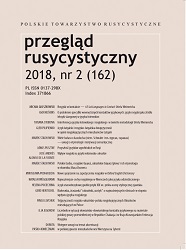
The article deals with the specifics of the Latvian-Russian language contact and one of its results — slang words and barbarisms. The author consideres also motivations of this kind of borrowings from Russian in the Latvian language. Uriel Weinreich pre¬sented the classification of “motivations of lexical borrowings” in his book Languages in contact. Some postulates of Weinreich’s research can be applied to the study of Russian-Latvian language contacts connected with distribution of slang words. A lar¬ge number of the Russianisms entered in colloquial Latvian as a result of oral com-munication. Slavisms in the colloquial speech (slang) have been borrowed because of internal language contacts and bilingualism. Russian language was eveolving in a so¬ciolinguistic situation of collective bilingualism that assumes the existence of internal language contacts. It is possible to classify Russianisms-barbarisms from the point of view of their motivation in several groups, which are described in the article. Various degrees of adaptation of slang words in Latvian show that various types of lexical in¬terference are parts of one dynamic process.
More...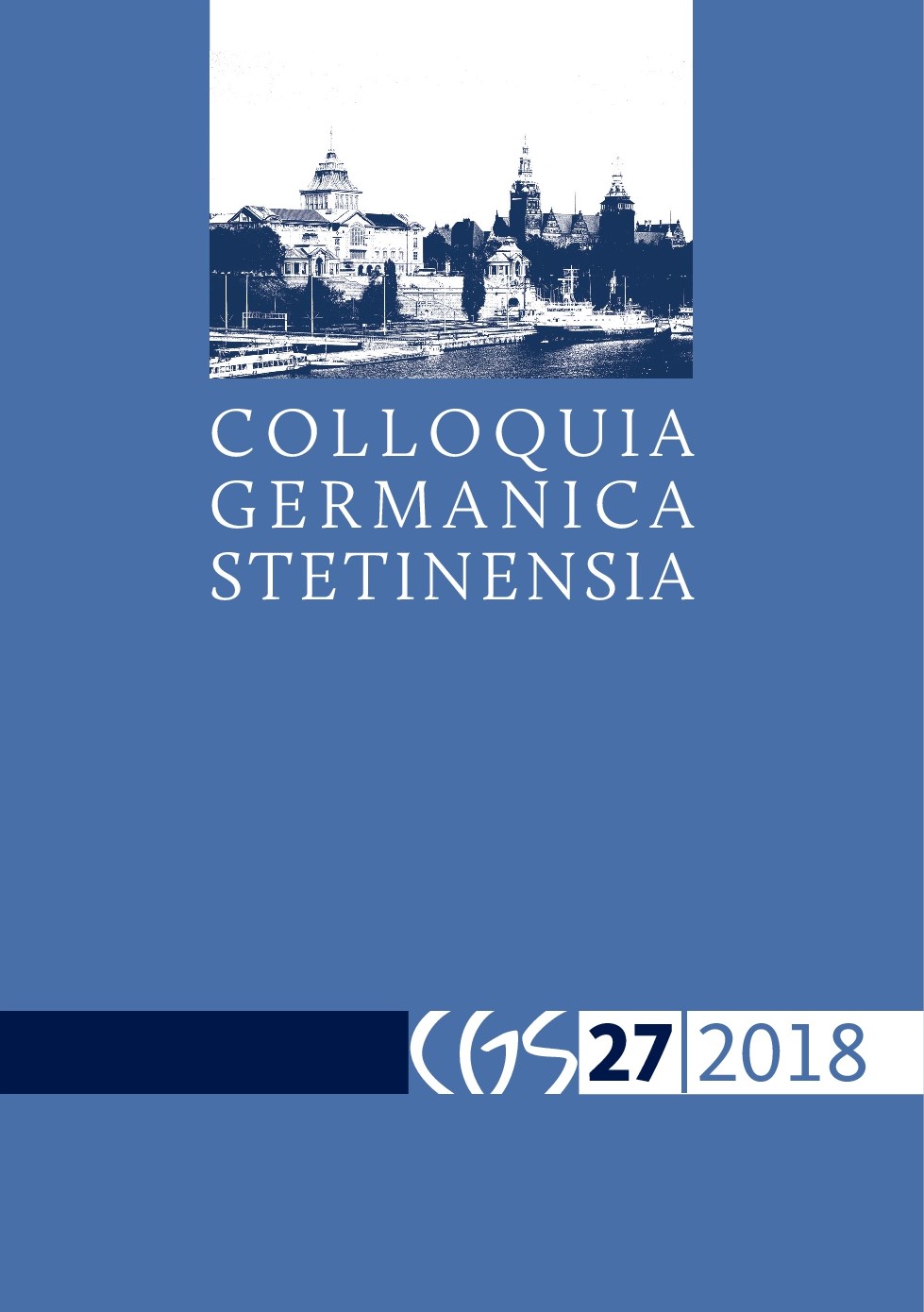
The study aims to investigate the processing of four simultaneously activated languages, that is, Polish as L1, German as L2, English as L3 and Swedish as L4, in written L4 production. Errors which can be attributed to negative transfer and interference, as well as the participants’ ability to exploit the similarities between the languages, which reflects their language awareness, are analysed here. As the results show, all the four languages are indeed activated and participate in the processing, but at the same time a lot of intralingual interaction between Swedish words and structures can be observed, and despite the language distance, the native language also remains an important source of transfer and interference.
More...